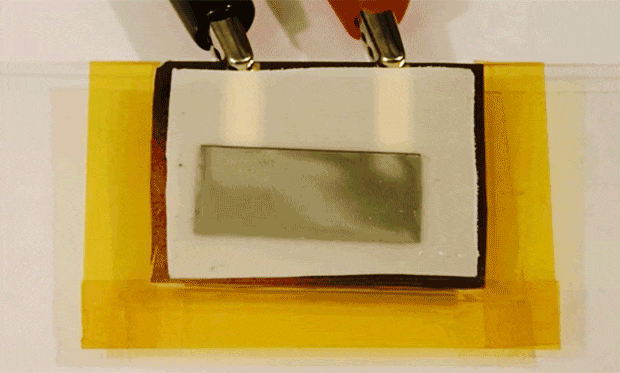Mission Impossible Self-Destructing Gadgets Not So Impossible
A new self-destruct mechanism can destroy electronics within 10 seconds through wireless commands or the triggering of certain sensors.
Many government agencies and corporations would value such an extra layer of security for computing devices that might get lost or stolen. But past experiments with self-destructing electronics have either relied on new specialized chip designs or have taken far longer than 10 seconds. By comparison, the new self-destruct mechanism proposed by researchers at King Abdullah University of Science and Technology (KAUST) in Saudi Arabia can work swiftly and is compatible with the common semiconductor technology found in most electronic devices.
“The first customers would be the ones who need data protection: Intelligence communities, corporations, banks, hedge funds, social security administrations, collectors who handle massive data,” says Muhammad Mustafa Hussain, an electrical engineer at KAUST.
The self-destruct mechanism relies on an expandable polymer layer that can rapidly expand to around seven times its original volume when heated to temperatures above 80°C. The heat that triggers the polymer expansion comes from heater electrodes that could draw power from the battery of a smartphone or laptop. Full details of the study will be published in an upcoming issue of the journal Advanced Materials Technologies.
Roughly 500-600mW supplied to the heater electrodes enables the polymer to expand and crumple the chip within 10 to 15 seconds, but even lower power values of around 300mW could do the job in just over a minute. Several experiments showed that the polymer’s rapid expansion can destroy an adjacent silicon chip up to 90 micrometers thick.
“The expandable polymer expands much more and causes sufficient tension in the thin silicon—which is sitting on top of the polymer—so it simply crumples and then breaks,” Hussain says.
The temperature needed to activate the self-destruct mechanism could even be tuned between 80- and 250°C by using different polymeric materials. This is because the polymer layer consists of polymeric microspheres holding small amounts of liquid hydrocarbon. The thermoplastic shells of the microspheres soften when heated beyond a critical temperature, and release the liquid hydrocarbon. The released hydrocarbon undergoes phase change from liquid to gas and leads to the rapid polymer layer expansion.
The KAUST researchers tested several different Mission: Impossible–style scenarios that could autonomously trigger the self-destruct mechanism as a matter of security. One experiment showed how a GPS sensor could trigger it if the device is moved more than 50m away from its starting point.
A second experiment automatically triggered the self-destruct mechanism with a light sensor that was illuminated by a desk lamp. That test mimicked a security scenario where the top secret device was moved out of a box and exposed to light. And a third experiment used a pressure sensor to mimic an event where the chip self-destructs because the device casing is forced open.
The fourth scenario tested the ability for an agent or some other person to remotely trigger the self-destruct command by using a smartphone app. When the researchers entered a password into the app, the chip was destroyed on demand.
Despite the promising early results, Hussain and his colleagues have much more testing in mind. For example, they plan to try out the self-destruct mechanism on printed circuit boards and magnetic hard drives. They also envision testing the expandable polymer’s capability to destroy multiple levels of stacked silicon wafers, or even just select layers.
The KAUST team also wants to demonstrate more localized self-destruct options. Careful positioning of the internal components, adjustment of the thickness values for the polymer layers, and different heater locations could restrict the destruction to specific device components such as a laptop’s memory chips.
Such a self-destruct mechanism could even potentially be retrofitted to existing laptop or desktop computers, Hussain says. He added that the overall cost of adding the self-destruct security mechanism would likely be about $15 or less, depending on volume.
Creating a self-destruct option that works quickly and is compatible with today’s semiconductor chips is no small trick. In 2015, Xerox PARC showed off a self-destructing chip made on strained glass that could shatter within 10 seconds when triggered by a laser. That was developed as part of the U.S. Defense Advanced Research Projects Agency’s (Darpa’s) Vanishing Programmable Resources program. But the downside of that approach is that it relies on a specialized chip design rather than being readily compatible with modern semiconductor chips.
The same DARPA program has also considered but not yet demonstrated using small etchant liquids stored in tiny microcavities that could dissolve device components. The University of Illinois lab of John Rogers has also tested the ability to dissolve chips with chemicals contained in microfluidic channels, but this self-destruct mechanism works more slowly than the rapidly expanding polymer approach.
The need to protect sensitive data from falling into the wrong hands will likely only continue to grow—and not just for the fictional character Ethan Hunt or real-life intelligence agencies. So even a self-destruct option that needs 10 seconds instead of five seconds should be welcome news.
More information: IEEE Spectrum


